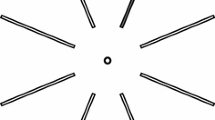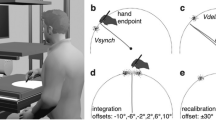Abstract
We previously investigated sensory coupling of the sensed positions of cursor and hand in a cursor-control task and found differential characteristics of implicit and explicit measures of the bias of sensed hand position toward the position of the cursor. The present study further tested whether adaptation to a visuomotor rotation differentially affects these two measures. Participants made center-out reaching movements to remembered targets while looking at a rotated feedback cursor. After sets of practice trials with constant (adaptation condition) or random (control condition) visuomotor rotations, test trials served to assess sensory coupling. In these trials, participants judged the position of the hand at the end of the center-out movement, and the deviation of these judgments from the physical hand positions served as explicit measure of the bias of sensed hand position toward the position of the cursor, whereas the implicit measure was based on the direction of the return movement. The results showed that inter-individual variability of explicitly assessed biases of sensed hand position toward the cursor position was less in the adaptation condition than in the control condition. Conversely, no such changes were observed for the implicit measure of the bias of sensed hand position, revealing contrasting effects of adaptation on the explicit and implicit measures. These results suggest that biases of explicitly sensed hand position reflect sensory coupling of neural representations that are altered by visuomotor adaptation. In contrast, biases of implicitly sensed hand position reflect sensory coupling of neural representations that are unaffected by adaptation.






Similar content being viewed by others
References
Abeele, S., & Bock, O. (2001a). Mechanisms for sensorimotor adaptation to rotated visual input. Experimental Brain Research, 139, 248–253.
Abeele, S., & Bock, O. (2001b). Sensorimotor adaptation to rotated visual input: Different mechanisms for small versus large rotations. Experimental Brain Research, 140, 407–410.
Bock, O., & Eckmiller, R. (1986). Goal-directed arm movements in absence of visual guidance: Evidence for amplitude rather than position control. Experimental Brain Research, 62, 451–458.
Bresciani, J.-P., Dammeier, F., & Ernst, M. O. (2006). Vision and touch are automatically integrated for the perception of sequences of events. Journal of Vision, 6, 554–564.
Brown, L. E., Rosenbaum, D. A., & Sainburg, R. L. (2003a). Limb position drift: Implications for control of posture and movement. Journal of Neurophysiology, 90, 3105–3118.
Brown, L. E., Rosenbaum, D. A., & Sainburg, R. L. (2003b). Movement speed effects on limb position drift. Experimental Brain Research, 153, 266–274.
Buch, E. R., Young, S., & Contreras-Vidal, J. L. (2003). Visuomotor adaptation in normal aging. Learning & Memory, 10, 55–63.
Cheng, K., Shettleworth, S. J., Huttenlocher, J., & Rieser, J. J. (2007). Bayesian integration of spatial information. Psychological Bulletin, 133, 625–637.
Cressman, E. K., & Henriques, D. Y. P. (2009). Sensory recalibration of hand position following visuomotor adaptation. Journal of Neurophysiology, 102, 3505–3518.
Cressman, E. K., & Henriques, D. Y. P. (2010). Reach adaptation and proprioceptive recalibration following exposure to misaligned sensory input. Journal of Neurophysiology, 103, 1888–1895.
Debats, N. B., Ernst, M. O., & Heuer, H. (2017). Perceptual attraction in tool-use: Evidence for a reliability-based weighting mechanism. Journal of Neurophysiology, 117, 1569–1580.
Dijkerman, H. C., & de Haan, E. H. F. (2007). Somatosensory processes subserving perception and action. Behavioral and Brain Sciences, 30, 189–239.
Ernst, M. O. (2006). A Bayesian view on multimodal cue integration. In G. Knoblich, I. M. Thornton, M. Grosjean, & M. Shiffrar (Eds.), Human body perception from the inside out (pp. 105–131). Oxford: Oxford University Press.
Ernst, M. O. (2012). Optimal multisensory integration: Assumptions and limits. In B. E. Stein (Ed.), The New Handbook of Multisensory Processes (pp. 1084–1124). Cambridge: MIT Press.
Ernst, M. O., & Bülthoff, H. H. (2004). Merging the senses into a robust percept. Trends in Cognitive Sciences, 8, 162–169.
Goble, D. J., Coxon, J. P., Van Impe, A., Geurts, M., Van Hecke, W., Sunaert, S., … Swinnen, S. P. (2012). The neural basis of central proprioceptive processing in older versus younger adults: An important sensory role for right putamen. Human Brain Mapping, 33, 895–908.
Harrar, V., & Harris, L. R. (2008). The effect of exposure to asynchronous audio, visual, and tactile stimulus combinations on the perception of simultaneity. Experimental Brain Research, 186, 517–524.
Harrar, V., Harris, L. R., & Spence, C. (2017). Multisensory integration is independent of perceived simultaneity. Experimental Brain Research, 235, 763–775.
Hatada, Y., Miall, R. C., & Rossetti, Y. (2006). Long-lasting aftereffect of a single prism adaptation: shifts in vision and proprioception are independent. Experimental Brain Research, 173, 415–424.
Hay, J. C., Pick, H. L., & Ikeda, K. (1965). Visual capture produced by prism spectacles. Psychonomic Science, 2, 215–216.
Heuer, H., Hegele, M., & Rand, M. K. (2013). Age-related variations in the control of electronic tools. In C. M. Schlick, E. Frieling, & J. Wegge (Eds.), Age-Differentiated Work Systems (pp. 369–390). Heidelberg: Springer.
Heuer, H., & Sangals, J. (1998). Task-dependent mixtures of coordinate systems in visuomotor transformations. Experimental Brain Research, 119, 224–236.
Heuer, H., & Sülzenbrück, S. (2012). The influence of the dynamic transformation of a sliding lever on aiming errors. Neuroscience, 207, 137–147.
Holmes, N. P., Crozier, G., & Spence, C. (2004). When mirrors lie: “Visual capture” of arm position impairs reaching performance. Cognitive, Affective & Behavioral Neuroscience, 4, 193–200.
Holmes, N. P., & Spence, C. (2005). Visual bias of unseen hand position with a mirror: Spatial and temporal factors. Experimental Brain Research, 166, 489–497.
Izawa, J., Criscimagna-Hemminger, S. E., & Shadmehr, R. (2012). Cerebellar contributions to reach adaptation and learning sensory consequences of action. Journal of Neuroscience, 32, 4230–4239.
Kagerer, F. A., Contreras-Vidal, J. L., & Stelmach, G. E. (1997). Adaptation to gradual as compared with sudden visuo-motor distortions. Experimental Brain Research, 115, 557–561.
Kavounoudias, A., Roll, J. P., Anton, J. L., Nazarian, B., Roth, M., & Roll, R. (2008). Proprio-tactile integration for kinesthetic perception: An fMRI study. Neuropsychologia, 46, 567–575.
Kirsch, W., Pfister, R., & Kunde, W. (2016). Spatial action–effect binding. Attention, Perception & Psychophysics, 78, 133–142.
Krakauer, J. W., & Mazzoni, P. (2011). Human sensorimotor learning: Adaptation, skill, and beyond. Current Opinion in Neurobiology, 21, 1–9.
Krakauer, J. W., Pine, Z. M., Ghilardi, M. F., & Ghez, C. (2000). Learning of visuomotor transformations for vectorial planning of reaching trajectories. Journal of Neuroscience, 20, 8916–8924.
Ladwig, S., Sutter, C., & Müsseler, J. (2012). Crosstalk between proximal and distal action effects during tool use. Zeitschrift für Psychologie, 220, 10–15.
Ladwig, S., Sutter, C., & Müsseler, J. (2013). Intra- and intermodal integration of discrepant visual and proprioceptive action effects. Experimental Brain Research, 231, 457–468.
Levene, H. (1960). Robust tests for equality of variances. In I. Olkin, S. G. Ghurye, W. Hoeffding, W. G. Madow, & H. B. Mann (Eds.), Contributions to Probability and Statistics: Essays in Honor of Harold Hotelling (pp. 278–292). Stanford: Stanford University Press.
Milner, A. D., & Goodale, M. A. (1995). The Visual Brain in Action. Oxford: Oxford University Press.
Milner, A. D., & Goodale, M. A. (2008). Two visual systems re-viewed. Neuropsychologia, 46, 774–785.
Morehead, J. R., Qasim, S. E., Crossley, M. J., & Ivry, R. (2015). Savings upon re-aiming in visuomotor adaptation. Journal of Neuroscience, 35, 14386–14396.
Neggers, S. F. W., & Bekkering, H. (2000). Ocular gaze is anchored to the target of an ongoing pointing movement. Journal of Neurophysiology, 83, 639–651.
Paillard, J. (1991). Motor and representational framing of space. In J. Paillard (Ed.), Brain and Space (pp. 163–182). Oxford: Oxford University Press.
Proske, U., & Gandevia, S. C. (2012). The proprioceptive senses: Their roles in signaling body shape, body position and movement, and muscle force. Physiological Reviews, 92, 1651–1697.
Rand, M. K., & Heuer, H. (2013). Implicit and explicit representations of hand position in tool use. PLoS ONE, 8, e68471.
Rand, M. K., & Heuer, H. (2016). Effects of reliability and global context on explicit and implicit measures of sensed hand position in cursor-control tasks. Frontiers in Psychology, 6, 2056.
Rand, M. K., & Heuer, H. (in press). Dissociating explicit and implicit measures of sensed hand position in tool use: effect of relative frequency of judging different objects. Attention, Perception, & Psychophysics.
Rand, M. K., & Stelmach, G. E. (2010). Effects of hand termination and accuracy constraint on eye-hand coordination during sequential two-segment movements. Experimental Brain Research, 207, 197–211.
Rand, M. K., Wang, L., Müsseler, J., & Heuer, H. (2013). Vision and proprioception in action monitoring by young and older adults. Neurobiology of Aging, 34, 1864–1872.
Reber, P. J. (2013). The neural basis of implicit learning and memory: A review of neuropsychological and neuroimaging research. Neuropsychologia, 51, 2026–2042.
Reichenbach, A., Thielscher, A., Peer, A., Bülthoff, H. H., & Bresciani, J.-P. (2014). A key region in the human parietal cortex for processing proprioceptive hand feedback during reaching movements. NeuroImage, 84, 615–625.
Rossetti, Y., Desmurget, M., & Prablanc, C. (1995). Vector coding of movement: Vision, proprioception, or both? Journal of Neurophysiology, 74, 457–463.
Schenk, T., Franz, V., & Bruno, N. (2011). Vision-for-perception and vision-for-action: Which model is compatible with the available psychophysical and neuropsychological data? Vision Research, 51, 812–818.
Shanks, D. R., & St. John, M. F. (1994). Characteristics of dissociable human learning systems. The Behavioral and Brain Sciences, 17, 367–447.
Simani, M. C., McGuire, L. M., & Sabes, P. N. (2007). Visual-shift adaptation is composed of separable sensory and task-dependent effects. Journal of Neurophysiology, 98, 2827–2841.
Synofzik, M., Lindner, A., & Thier, P. (2008). The cerebellum updates predictions about the visual consequences of one’s behavior. Current Biology, 18, 814–818.
Van Beers, R. J., Sittig, A. C., & Denier van der Gon, J. J. (1999). Integration of proprioceptive and visual position-information: An experimentally supported model. Journal of Neurophysiology, 81, 1355–1364.
Van Beers, R. J., Wolpert, D. M., & Haggard, P. (2002). When feeling is more important than seeing in sensorimotor adaptation. Current Biology, 12, 834–837.
Van Dam, L. C. J., & Ernst, M. O. (2013). Knowing each random error of our ways, but hardly correcting for it: An instance of optimal performance. PLoS ONE, 8, e78757.
Vindras, P., Desmurget, M., Prablanc, C., & Viviani, P. (1998). Pointing errors reflect biases in the perception of the initial hand position. Journal of Neurophysiology, 79, 3290–3294.
Welch, R. B. (1978). Perceptual modification. Adapting to altered sensory environments. New York: Academic Press.
Wendker, N., Sack, O. S., & Sutter, C. (2014). Visual target distance, but not visual cursor path length produces shifts in motor behavior. Frontiers in Psychology, 5, 225.
Wilke, C., Synofzik, M., & Lindner, A. (2013). Sensorimotor recalibration depends on attribution of sensory prediction errors to internal causes. PLoS ONE, 8, e54925.
Zbib, B., Henriques, D. Y. P., & Cressman, E. K. (2016). Proprioceptive recalibration arises slowly compared to reach adaptation. Experimental Brain Research, 234, 2201–2213.
Acknowledgements
This research was supported by the German Research Foundation (DFG) (Grant number Ra 2183/1-3). We thank Maleen Greine and Franziska Schywalski for their support in data collection.
Author information
Authors and Affiliations
Corresponding author
Ethics declarations
Funding
This study was funded by the German Research Foundation (DFG) (Grant number Ra 2183/1-3).
Conflict of interest
Miya Rand declares that she has no conflict of interest. Herbert Heuer declares that he has no conflict of interest.
Ethical approval
All procedures performed in studies involving human participants were in accordance with the ethical standards of the institutional research committee and with the 1964 Helsinki declaration and its later amendments or comparable ethical standards.
Informed consent
Informed consent was obtained from all individual participants included in the study.
Rights and permissions
About this article
Cite this article
Rand, M.K., Heuer, H. Contrasting effects of adaptation to a visuomotor rotation on explicit and implicit measures of sensory coupling. Psychological Research 83, 935–950 (2019). https://doi.org/10.1007/s00426-017-0931-1
Received:
Accepted:
Published:
Issue Date:
DOI: https://doi.org/10.1007/s00426-017-0931-1




